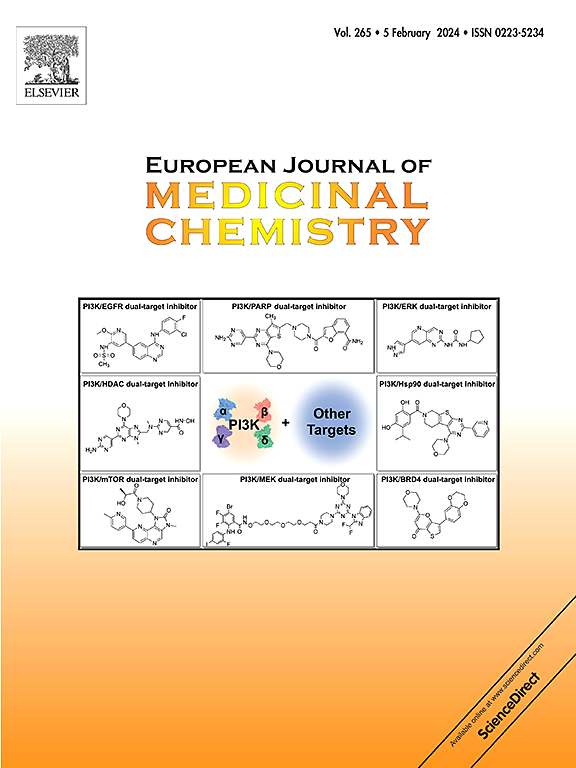发现一种新的靶向YB-1的Genipin衍生物,以增强p糖蛋白介导的紫杉醇耐药非小细胞肺癌的紫杉醇敏感性
IF 6
2区 医学
Q1 CHEMISTRY, MEDICINAL
引用次数: 0
摘要
非小细胞肺癌(NSCLC)是最常见的肺癌类型,其发病率和死亡率都比较高。紫杉醇作为经典的化疗药物,已成为临床上晚期NSCLC患者常用的一线药物之一,但多药耐药已成为严重制约其疗效的主要因素。因此,克服对紫杉醇的多药耐药是提高其疗效迫切需要解决的重要问题。本研究以亚甲基吲哚酮和吉尼平为中间体,合成了23个吉尼平的新衍生物。当它们与紫杉醇联合使用时,大多数在p- gp介导的紫杉醇耐药非小细胞肺癌细胞(A549/Taxol细胞)中表现出良好的逆转活性。其中最有效的化合物13可通过靶向YB-1,降低YB-1总蛋白的表达和细胞核内YB-1蛋白的水平,从而抑制下游蛋白P-gp的表达和功能,进一步抑制紫杉醇外排速率,增加细胞内紫杉醇浓度,从而增强A549/Taxol细胞对紫杉醇的敏感性。此外,化合物13与紫杉醇联合治疗可显著降低紫杉醇耐药肺癌异种移植物的肿瘤生长。小鼠脏器H&;E染色及A549/Taxol肿瘤组织免疫组化分析表明,化合物13可增强紫杉醇耐药NSCLC的紫杉醇敏感性,具有较低的细胞毒性。这些结果清楚地表明,化合物13通过靶向YB-1,可能作为一种新的化学增敏剂与紫杉醇联合治疗非小细胞肺癌,以克服耐多药。本文章由计算机程序翻译,如有差异,请以英文原文为准。

Discovery of a novel Genipin derivative targeting YB-1 to enhance the P-glycoprotein-mediated paclitaxel sensitivity of paclitaxel-resistant non-small cell lung cancer
Non-small cell lung cancer (NSCLC) is the most common type of lung cancer, and its incidence rate and mortality are relatively high. Paclitaxel, a classic chemotherapy drug, has become one of the first-line drugs commonly used for patients with advanced NSCLC in clinical practice, but multidrug resistance has become a major factor seriously restricting its efficacy. Therefore, overcoming multidrug resistance to paclitaxel is an important issue that urgently needs to be addressed to improve its efficacy. In our study, twenty-three novel derivatives of Genipin were synthesized by using different intermediates of methylene indole ketones and Genipin. When they were combined with paclitaxel, most of them exhibited good reversal activity in P-gp-mediated paclitaxel-resistant non-small cell lung cancer cells (A549/Taxol cells). The most potent compound 13 could enhance the sensitivity of A549/Taxol cells with low cytotoxicity to paxlitaxel by targeting YB-1 and reducing the expression of total YB-1 protein and the level of YB-1 protein in the nucleus, thus inhibiting the expression and function of the downstream protein P-gp, further suppressing the efflux rate of paclitaxel and increasing the concentration of intracellular paclitaxel. In addition, tumour growth in paclitaxel-resistant lung cancer xenografts was significantly decreased by combination treatment with compound 13 and paclitaxel. H&E staining of mouse organs and IHC analysis of A549/Taxol tumour tissues indicated that compound 13 could enhance the paclitaxel sensitivity of paclitaxel-resistant NSCLC, with low cytotoxicity. These results clearly indicate that compound 13, by targeting YB-1, might be useful as a novel chemosensitizer in combination with paclitaxel to overcome MDR in the management of NSCLC.
求助全文
通过发布文献求助,成功后即可免费获取论文全文。
去求助
来源期刊
CiteScore
11.70
自引率
9.00%
发文量
863
审稿时长
29 days
期刊介绍:
The European Journal of Medicinal Chemistry is a global journal that publishes studies on all aspects of medicinal chemistry. It provides a medium for publication of original papers and also welcomes critical review papers.
A typical paper would report on the organic synthesis, characterization and pharmacological evaluation of compounds. Other topics of interest are drug design, QSAR, molecular modeling, drug-receptor interactions, molecular aspects of drug metabolism, prodrug synthesis and drug targeting. The journal expects manuscripts to present the rational for a study, provide insight into the design of compounds or understanding of mechanism, or clarify the targets.

 求助内容:
求助内容: 应助结果提醒方式:
应助结果提醒方式:


